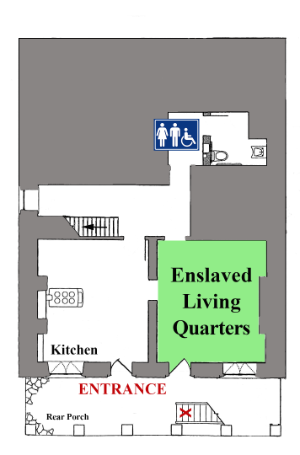JACKSON HOUSE MUSEUM
ENSLAVED LIVING QUARTERS
No records exist detailing life of the enslaved persons who lived in the house. This room represents a common sleeping area for enslaved servants in an urban community, such as Lexington, during the 1850s. In addition to providing personal living space, the room may have shared several other functions such as a storage area and work space.
Imagine it is late 1860: the holiday season – a very tense time in Lexington and throughout the United States. It is the beginning of the secession crisis. Lexington has about twenty-one hundred people. One-third of them are black; about 90 are free, and 600 enslaved. The Jacksons owned six enslaved people at this time, and five of them live on this property. I am Larry Spurgeon, a senior researcher for the Stonewall Jackson House. This room is intended to depict how the living quarters for the enslaved people may have been at that time. We don’t know much about the sleeping arrangements, but it is very possible that Amy, the cook, slept here, or nearby, on this lower level to be close to the kitchen and to light the stove very early in the morning. The room would have been spare and sparse – a bed, a chair, a table, clothing, some personal items. Hetty and Emma, the other two females, probably slept in this house – possibly on this level. Hetty had been given to the Jacksons by Anna’s father after their marriage, along with her sons Cyrus and George. Emma had been purchased just a couple of months ago by Thomas Jackson. Cyrus and George, who are 17 and 15, probably slept in a building in the back, because Thomas Jackson, uh, reported in the 1860 census that he had a separate slave house. The daily lives of these five enslaved people would have been typical for enslaved people in Lexington – full of work. Their movements around the community would have been severely restricted by local and state law. In a few months, Major Jackson will go to war. A couple of months later Anna will go to North Carolina to stay with her parents. The five enslaved people will be sent to live with other people in the area for the duration of the war, except for Hetty, who will return to North Carolina in 1862 for the birth of Julia. In recent years, we have learned a great deal about the post-war lives of Hetty, George, and Emma and have had the privilege of meeting some of their descendants. It is a project that is very exciting and continues.
Jackson Family Items
The Jackson House currently does not have any artifacts related to the enslaved members of the household. The enslaved would have had few personal possessions. Such items either deteriorated or were discarded over time, or perhaps remain in the possession of descendants.
